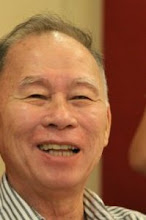– Fr. Reuter speaks about his martial law experience.
Inspired by Ana Marie Pamintuan
There are widely divergent versions of why nine members of a farmers’ group were murdered on Saturday night in a sugar plantation in Sagay, Negros Occidental. All the versions, however, bear a common thread: the victims wanted a piece of that land.
Whether they were promised ownership if they simply pitched a makeshift tent on the land – and they naively believed it - or they deliberately set off to occupy and seize private property, the slaughter dramatizes the sad plight of the poorest of the poor in our country.
Poverty is no excuse to illegally occupy private property, or jump the line in occupying subsidized housing meant for government workers, many of whom are also living below or near the poverty line. Yes, Juan and Juana, these include cops and soldiers.
But murdering nine individuals for encroaching on a sugar plantation is overkill, no pun intended. A hacienda owner who resorts to mass murder to keep the militant poor from grabbing land should know the country enough to worry about lethal retaliation from the New People’s Army (NPA).
Maybe the owner of the plantation called Hacienda Nene, identified as Carmen Tolentino, has her own armed security group to keep out trespassers and even NPA raiders. But under normal circumstances, the constant threat of retaliation should be enough to compel a reasonable businesswoman to seek government help instead in evicting illegal land occupants.
Who would massacre nine impoverished people? In the age of Tokhang and Double Barrel (although these are directed at drugs, not insurgencies) and the continuing skirmishing between government forces and the NPA, suspicion falls quickly on the military and police. Left-leaning groups have pointed to militias of the Philippine Army as the prime suspects in the murders of the National Federation of Sugar Workers’ chair for Sagay, Flora Jemola, in December 2017, and member Ronald Manlanat on Feb. 21 this year. Most of the nine victims last Saturday reportedly belonged to the NFSW.
Those who reject this premise, however, point out that precisely because government forces are expected to get the blame, it’s not entirely implausible that certain elements in the insurgency were behind the massacre – to stoke anti-government sentiment and generate sympathy for the rebel movement.
Hacienda Nene covers 75 hectares and has avoided redistribution. The nine fatalities, according to initial reports, were part of a group that occupied what they considered idle land to till for their personal use.
These are people who can easily buy the promise of ownership if they simply pitch a tent and occupy the land.
This murder of the 9 Sagay farmers is reminiscent of what happened in El Salvador around 1980 where Archbishop Oscar Romero was shot dead while saying Mass. The following is his story. Let us pray the Sagay murders will not bring us to this situation as evidenced by our Marcos Era Martial Law
Archbishop Oscar Romero of El Salvador drew inspiration from his close Jesuit friend Father Rutilio Grande S.J., who was assassinated for his own work seeking justice for the poor in El Salvador in 1977. At Fr. Grande’s funeral, Archbishop Romero said “the liberation Fr. Grande preached was inspired by faith.”
On March 24, 1980, the archbishop was himself shot to death by a right-wing death squad while celebrating the Eucharist. Since then, the people of El Salvador and many others from various parts of the world have revered him as a martyr. After more than 3 decades, Rome finally officially recognized his martyrdom. He was beatified on May 23, 2015, and was canonized on October 14, 2018. Why is Oscar Romero honored as a prophet? What is the meaning of his martyrdom?
Traditionally, the recognition of martyrdom was reserved for those put to death in odium fidei or in hatred of the faith during times of persecution. There were times in the past when Christians were hated on account of their faith. There were doubts whether he was really murdered in odium fidei. This was one of the reasons for the slow progress of his cause. In 2014, when asked about Romero's martyrdom, Pope Francis commented:
"What I would like is a clarification about martyrdom in odium fidei, whether it can occur either for having confessed the Creed or for having done the works which Jesus commands with regard to one’s neighbor. And this is a task for theologians."
Thus, in February 2015, when asking Pope Francis to recognize Romero's martyrdom, the Congregation for the Causes of Saints affirmed:
"He was killed at the altar. Through him, they wanted to strike the church that flowed from the Second Vatican Council. His assassination was not caused by motives that were simply political, but by hatred for a faith that, imbued with charity, would not be silent in the face of the injustices that relentless and cruelly slaughtered the poor and their defenders."
FATHER JAMES REUTER S.J. SPEAKS ON HIS MARTIAL LAW EXPERIENCE.
Fr. Reuter speaks for the people



